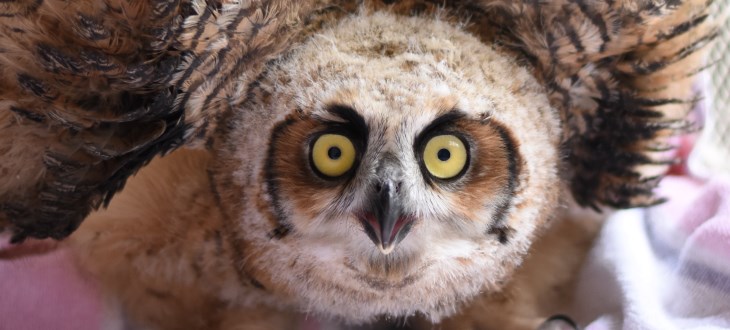The State We're In
Owl spotting in winter
With the final leaves of fall on the ground, it’s time to look for owls!
Winter is prime season for spotting and listening for owls, those incredibly mysterious and beautiful birds rarely seen up close in broad daylight.
“Owls are a little more obvious at this time of year because the leaves have fallen off the trees,” says Shari Stern, education director at the Raptor Trust in Millington. And because of the shorter daylight hours, she notes, people are more likely to be out at dawn and dusk when many owls are active.
Owls are fascinating for their huge round eyes with excellent night vision, necks that swivel 270 degrees and feathers adapted for silent flight.
New Jersey’s year-round owls include great horned, Eastern screech, barred and, less common, short-eared, long-eared, barn and saw-whet owls. In winter, our resident owls are often joined by snowy owls that migrate from the north in search of a steadier food supply, and short-eared, long-eared and saw-whet owls from the north. Barn owls usually migrate south from New Jersey in winter, but a few may stick around.
What’s the best way to spot owls this winter? Look very carefully in tree branches, advises Giselle Chazot Smisko, director of the Avian Wildlife Center in Wantage.
Owls may nap in tree branches during daylight hours, but they can also be alert and hunting, especially in dark, rainy and cloudy weather.
“The greatest challenge is that owls can camouflage themselves very well,” says Giselle. “You can absolutely be looking right at an owl and only see the tree. They’re able to move every feather on their body, so they can fluff themselves to look very round or flatten themselves to look like a branch.”
Look on the ground for chalky white droppings and grey pellets of indigestible bones and fur below trees. These usually indicate an owl’s favorite roosting place.
It’s likely, though, that you will hear them first.
New Jersey’s largest and best-known owl is the great horned – nicknamed the hoot owl – which makes a distinctive HOOH-hoo-hoo-hooh-HOOOOH-hooh call at night.
Great horned owls breed in early winter, starting of their mating and nesting season in December. “They’re calling now to establish their territories and find mates,” explains Giselle.
Great horned owls feed on small animals – mice, moles, rabbits, squirrels and skunks – and other birds, including crows and hawks. Look for the large feather tufts on the top of their heads, resembling cat ears.
Most other New Jersey owls breed in late winter, which is a great time to hear courtship calls at night. Screech owls are especially fun to identify, with their distinctive shrill, descending whinny – similar to a horse – and their even-noted trilling.
“I call screech owls our suburban owls,” said Giselle. “They could be nesting in someone’s yard and the people might not know.”
Snowy owls are rare in New Jersey, but have been spotted in past winters in Liberty State Park, Island Beach State Park and the Merrill Creek Reservoir. As of this week, snowy owls have not been seen as far south as New Jersey, but they’re still on the move.
Northern saw-whets are New Jersey’s smallest owls, only about the size of a robin. Saw-whets are highly nocturnal and seldom seen, but you may hear their steady and flute-like “too-too-too-too” whistle. Recent saw-whet owl banding stations found them to be extremely common in winter.
While great horned owls are abundant in New Jersey, breeding short-eared owls are considered an endangered species in the state, and barred and long-eared owls are classified as threatened.
You can help owls by taking care of their habitat:
- Owls need large trees with cavities, so let dead trees on your property stand if they’re not a danger to people or structures. Many owls like to nest in these “snags.”
- Trim your trees in the fall or early winter rather than late winter or spring to avoid nesting owls. “It’s happened that we’ve received a nest full of baby owls because of tree trimming,” said Shari.
- Don’t use poison for rodent control; owls may eat mice that have ingested the poison.
- Keep an eye out for swooping owls when driving in winter, especially near open fields where they hunt. Owls fly low to catch their prey but are unable to judge the speed of oncoming traffic.
- If you spot an owl (or any other bird) that appears to be injured on the roadside, contact a rehabilitation facility like the Raptor Trust, the Avian Wildlife Center, or the Woodford Cedar Run Wildlife Refuge in Medford.
- Support the preservation of forests, meadows and marshes.
For guaranteed owl spotting, visit the Raptor Trust or the Woodford Cedar Run Wildlife Refuge. Both have resident owls that have been injured and cannot survive in the wild. The Avian Wildlife Center, Raptor Trust and Woodford Cedar Run Wildlife Refuge also provide public education programs at various locations using “ambassador” owls.
To learn more about owls, visit the Cornell Ornithology Lab’s “All About Birds” website at https://www.allaboutbirds.org/news/ or the National Audubon Society’s guide to North American birds at https://www.audubon.org/bird-guide.
And to learn more about preserving New Jersey’s land and natural resources, visit the New Jersey Conservation Foundation website at www.njconservation.org or contact me at info@njconservation.org.
About the Authors
Alison Mitchell
Co-Executive Director
John S. Watson, Jr.
Co-Executive Director
Tom Gilbert
Co-Executive Director, 2022-2023
Michele S. Byers
Executive Director, 1999-2021
View their full bios here.
Filter
Get The Latest News
From The Garden State
In the
News

